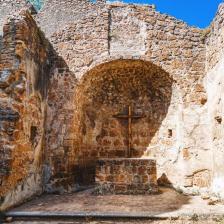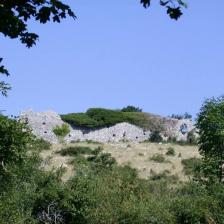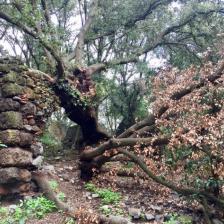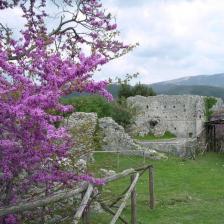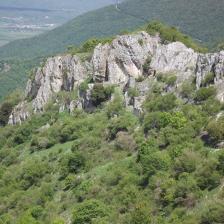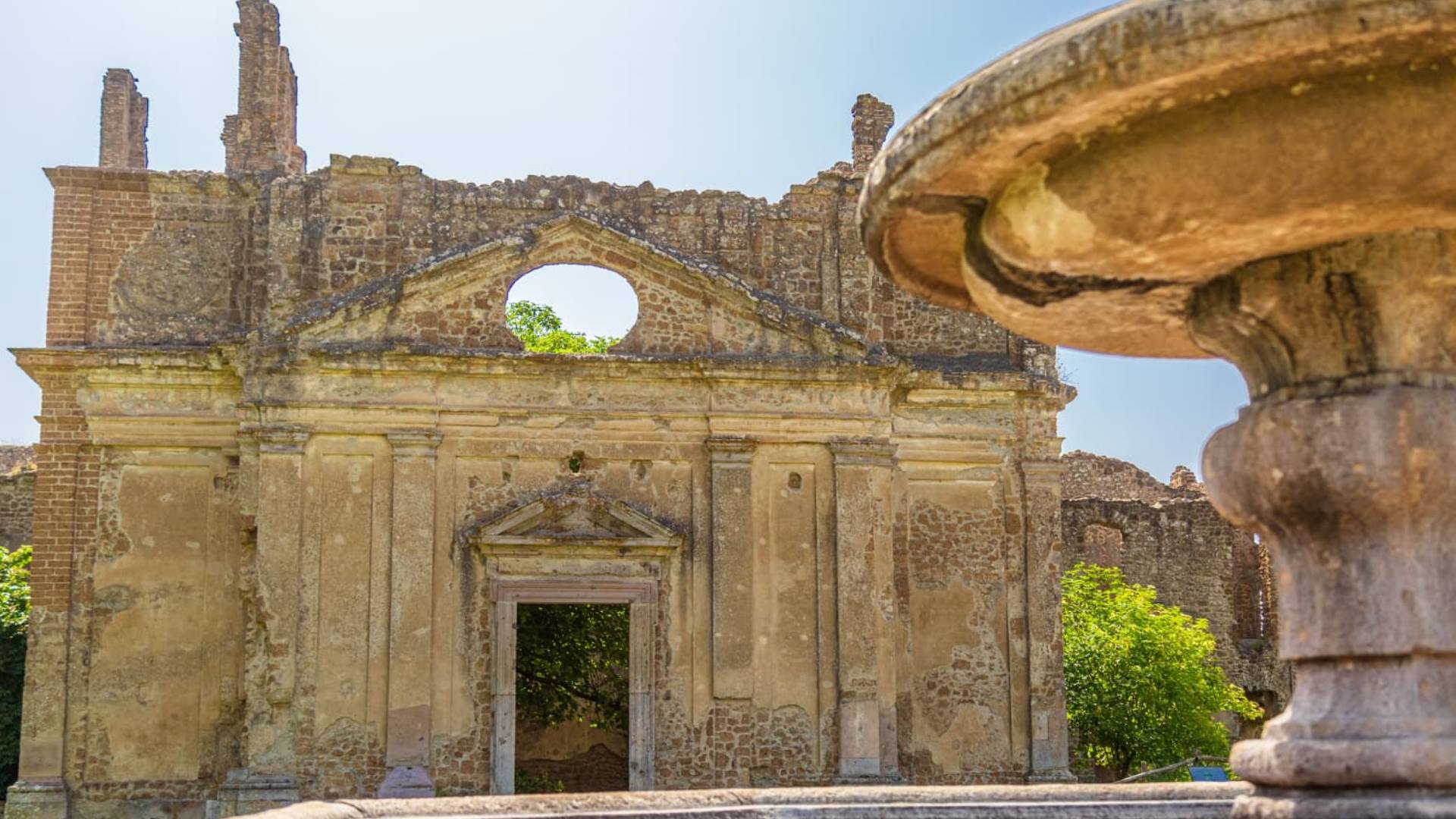
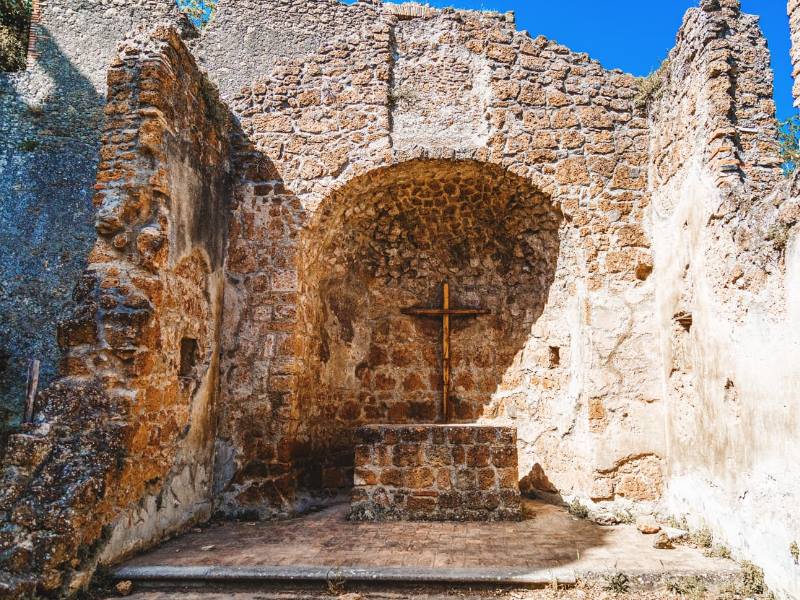
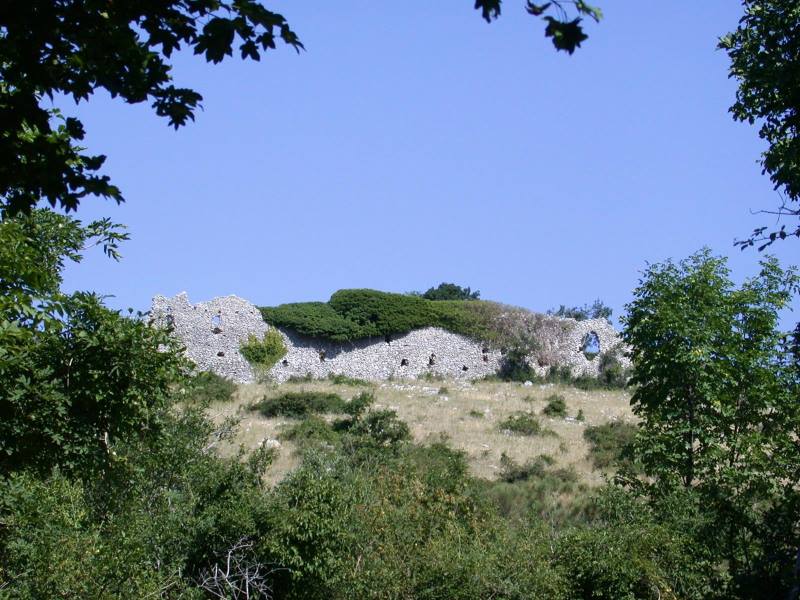
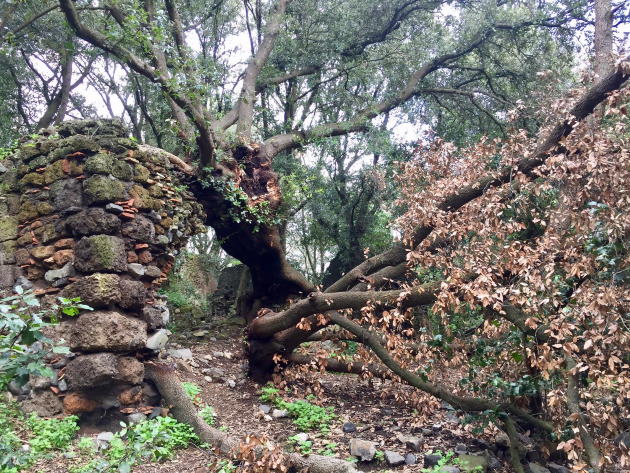
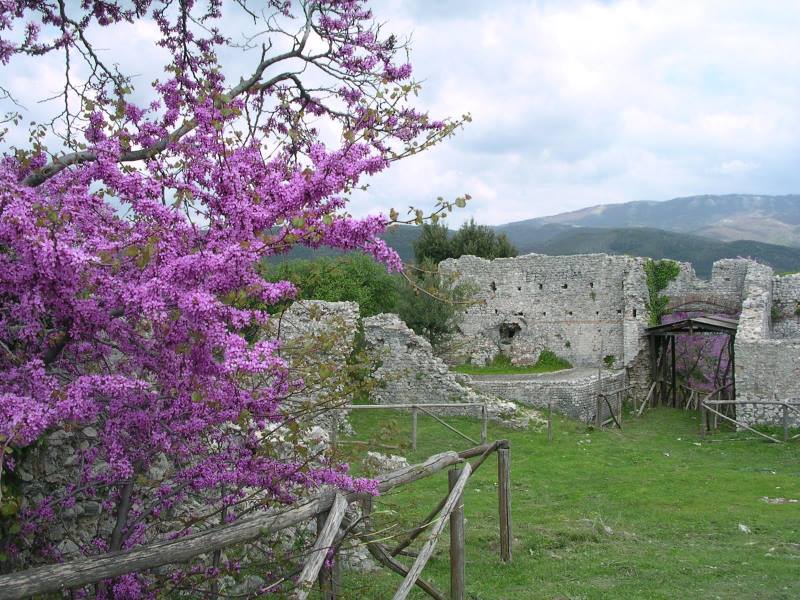
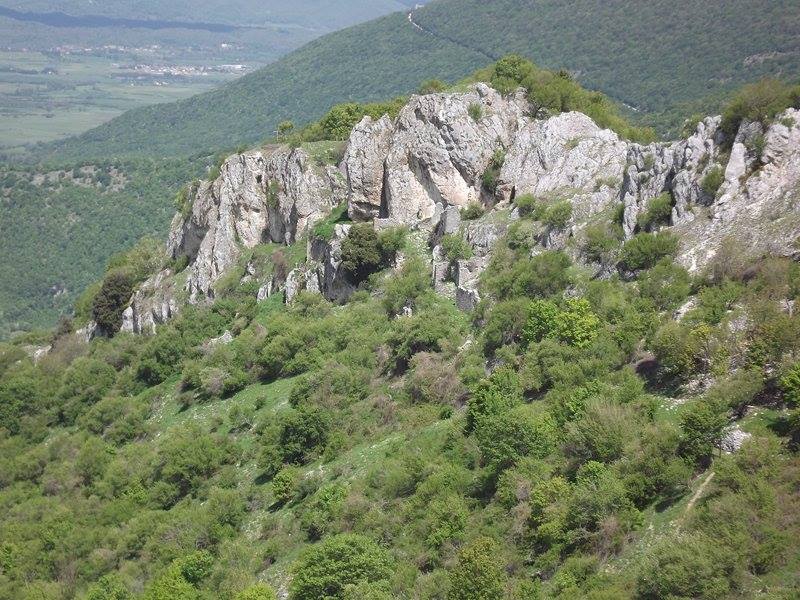
Eindrucksvolle Ruinen, verlassene Pfade und von der Zeit erodierte Steine. In der Umgebung von Rom verbergen sich viele kleine Dörfer und „Geisterstädte“, die seit Jahrhunderten verlassen sind und heute von Stille und einer bezaubernden Einsamkeit geprägt sind.
Was von diesen diskreten Schönheiten übrig geblieben ist, eingebettet in unberührte Landschaften, oft „klammernd” an Felsvorsprüngen und einst so sicher ihrer Stärke, ist das Zeugnis alter Geschichten, von Belagerungen, Duellen, Räubern, Lieben und Legenden.
Wir stellen Ihnen einige faszinierende verlassene Dörfer vor. Es handelt sich um geheimnisvolle Orte, die es wiederzuentdecken gilt und die selbst die anspruchsvollsten „Entdecker“ in Staunen versetzen und neugierig machen können.
Camerata Vecchia
Das alte Dorf Camerata Vecchia liegt etwas mehr als siebzig Kilometer östlich von Rom auf einem Felsvorsprung in über 1220 Metern Höhe. Das Dorf wurde um 900-960 n. Chr. erbaut. Der Name Camerata (oder „Camorata”) leitet sich von der Struktur der Häuser des Dorfes ab, die wie echte, in den Fels gehauene Kammern aussehen. Eine andere Theorie, die jedoch wenig wahrscheinlich ist, führt den Ursprung des Namens auf die „camerate di briganti” (Räuberhöhlen) zurück, die sich gewöhnlich in dem Dorf versteckten. Das Dorf war bis 1859 bewohnt. Am 9. Januar dieses Jahres wurde es durch einen plötzlichen und heftigen Brand zerstört, der der Überlieferung zufolge im Kamin eines Hauses ausbrach und sich dann auf das gesamte Dorf ausbreitete. Die überlebenden Dorfbewohner flüchteten in die nahe gelegene Kirche Madonna delle Grazie, die dem Feuer entgangen war und vielen Menschen bis zur Errichtung der neuen Siedlung Zuflucht bot.
Heute kann man noch den imposanten, in den Fels gehauenen Bogen aus dem 16. Jahrhundert, die Ruinen der Stadtmauer, den Stützbogen der Kirche San Salvatore und einige Wohnhäuser bewundern. Nicht zu versäumen ist die Piana di Camposecco, eine Weite aus ausgedehnten Wiesen und jahrhundertealten Buchenwäldern, eine atemberaubende Landschaft, die oft als Kulisse für Westernfilme dient, wie zum Beispiel für den berühmten Film „Sie nannten ihn Trinity”. Aufgrund der Beschaffenheit des Geländes, das nicht leicht zu erreichen ist, ist der Besuch etwas anspruchsvoll, aber absolut beeindruckend.
Castiglione
Die befestigte Siedlung Castiglione liegt abgeschieden im Naturpark Parco dei Monti Lucretili gegenüber von Palombara Sabina.
Eine doppelte Zinnenmauer umschließt eine Fläche von über tausend Quadratmetern. Es handelt sich um ein typisches Beispiel für ein mittelalterliches „Castrum”, das wahrscheinlich in der zweiten Hälfte des 12. Jahrhunderts auf den Überresten einer römischen Villa erbaut wurde.
Castiglione (oder Castrum Castillonis) wird in Dokumenten aus dem Jahr 1276 erwähnt. Bereits in den ersten Jahren des 15. Jahrhunderts scheint es jedoch verlassen worden zu sein, möglicherweise aufgrund von Epidemien, Kämpfen zwischen Adelsfamilien oder Erdbeben.
Von besonderem Interesse ist eine dem Heiligen Martin gewidmete Einsiedelei, die um das Jahr 1000 erbaut wurde und bis ins 17. Jahrhundert hinein genutzt wurde, zu einer Zeit, als das Dorf bereits seit zwei Jahrhunderten unbewohnt war. Die alte Festung bewahrt noch einige der ursprünglichen Türme und beherbergt in ihrem Inneren die Ruinen der Burg, die Kirche und eine große Zisterne, die aus dem wiederverwerteten Material der zuvor bestehenden römischen Villa erbaut wurde.
Galeria Antica
Galeria Antica liegt nördlich der Hauptstadt, in der Nähe der Via Braccianense, auf einem über 130 Meter hohen Tuffsteinfelsen, der vom Fluss Arrone umspült wird.
Die antike „tote Stadt” wurde wahrscheinlich zur Zeit der etruskischen Herrschaft unter dem Namen Careia gegründet, wie einige kleine Kammergräber in der unterhalb der Siedlung gelegenen Gegend bezeugen. Nach der etruskischen und dann der römischen Herrschaft wurde das Dorf von den Sarazenen belagert und wechselte im Laufe der Zeit mehrmals den Besitzer unter den römischen Adelsfamilien wie den Orsini, den Colonna, den Caetani, den Savelli und den Sanseverino. Die Malariaepidemie von 1700 führte zum Tod vieler Einwohner und 1809 zur endgültigen Aufgabe der Stadt auf recht mysteriöse Weise. Persönliche Gegenstände, Werkzeuge und sogar die Verstorbenen, die nicht begraben wurden, alles wurde in aller Eile zurückgelassen.
Seit zwei Jahrhunderten unbewohnt, liegt Galeria heute inmitten einer wunderschönen Naturoase, in der man noch den Glockenturm der Kirche San Nicola aus dem 18. Jahrhundert, die Ruinen der Burg und viele andere Gebäude bewundern kann, die zwischen der üppigen Vegetation verstreut liegen.
Montefalco
Die imposante mittelalterliche Siedlung Montefalco aus dem 13. Jahrhundert liegt in der Nähe von Monteflavio, etwa 50 km von Rom entfernt, in der Region Sabina.
Auf 900 Metern Höhe auf einem Hügel gelegen, genoss Montefalco eine strategisch günstige Lage. Aus diesem Grund wurde dort eine befestigte Siedlung mit einer Burg, Wohnhäusern, einer Zisterne und einer Verteidigungsmauer errichtet.
Das alte Anwesen von Montefalco wurde bereits 1422 aufgegeben, dem Jahr, in dem die ersten Nachrichten über das alte Monteflavio überliefert sind. Erst Ende des 16. Jahrhunderts wurde das Dorf dank der Familie Orsini am Fuße des Hügels wiederbelebt; daher der Name Monteflavio zu Ehren des Kardinals Flavio Orsini.
Erhalten sind Ruinen von Mauern, Türmen und einige Überreste von Wohnhäusern. Die Wanderung ist eindrucksvoll, aber recht anspruchsvoll und erfordert besondere Aufmerksamkeit und Bergsteigerausrüstung.
Antica Monterano
Dieses poetische, verlassene Dorf liegt westlich des Bracciano-Sees auf einem Tuffsteinhügel im Herzen des Naturschutzgebiets Monterano. In der Umgebung finden sich Spuren etruskischer Gräber, die einzigen Zeugnisse dieser Zivilisation in dieser Gegend. Ab dem 2. Jahrhundert v. Chr. wurde die Siedlung von den Römern und ab dem 4. Jahrhundert n. Chr. von den Langobarden beherrscht. In den folgenden Jahrhunderten erlebte das Dorf wechselhafte Geschicke. Im Jahr 1500 war es im Besitz der Familie Orsini. Mitte des 17. Jahrhunderts ging es in den Besitz der Familie Altieri über, dank der Monterano eine Blütezeit des Barock erlebte. So entstanden die Kirche und das Kloster San Bonaventura, der achteckige Brunnen, der Brunnen mit der Löwenstatue und die Fassade des Palazzo Ducale, ein Werk von Gian Lorenzo Bernini. Durch die Malariaepidemie dezimiert und nach dem Niedergang der weltlichen Macht des Papstes im Jahr 1798, kam das Dorf für kurze Zeit unter die Herrschaft der Römischen Republik, bis es von der bourbonischen Armee zurückerobert und schließlich von der französischen Armee endgültig zerstört wurde.
Das Panorama, das sich dem Betrachter bietet, ist spektakulär: Bauwerke und Überreste aus verschiedenen Epochen, eingebettet in üppige Vegetation, wie das antike römische Aquädukt, die Ruinen der Kirche San Rocco, der Porta Cretella, von Türmen und Wohnhäusern sowie die großartigen Werke Berninis. Im Laufe der Jahre war Monterano Drehort für Dutzende von Filmen, darunter „Il Marchese del Grillo“, „Ladyhawke“ und „Brancaleone alle crociate“. Nicht zu versäumen ist der eindrucksvolle Wasserfall Cascata della Diosilla mit seinem dantesken Aussehen und der vielfarbigen Färbung des Wassers.
Stazzano Vecchio
Die Ruinen dieser bezaubernden und wenig bekannten Siedlung befinden sich in der Nähe des gleichnamigen Dorfes in einem kleinen abgelegenen Tal der Sabina
Es gibt keine bedeutenden historischen Quellen über ihre Ursprünge. Der Ortskern entstand wahrscheinlich im Mittelalter auf den Überresten einer römischen Siedlung, rund um eine Burg, die zunächst im Besitz der Savelli und später anderer römischer Adelsfamilien war.
Ein einziges Tor ermöglichte den Zugang zum Dorf, das am 24. April 1901 nach einem heftigen Erdbeben der Stärke VIII auf der Mercalli-Skala endgültig aufgegeben wurde.
Heute kann man die Apsis der zerstörten Kirche Santa Maria, die beiden Hauptstraßen, die von den Ruinen der Häuser eingerahmt werden, und die Überreste der Burg mit ihren drei runden Türmen, den Mauern und dem imposanten Turm mit quadratischem Grundriss bewundern.
Umgeben von Wäldern und Obstbäumen ist Stazzano Vecchio dank der relativen Unversehrtheit des ursprünglichen Stadtgefüges wahrscheinlich ein echtes „Juwel” für Liebhaber von Geisterstädten, das jedoch aufgrund der strukturellen Merkmale des Gebiets besondere Aufmerksamkeit erfordert.
Berninis Brunnen und Kirche San Bonaventura Antica Monterano - Foto: canalemonterano.online Gemeinde Canale Monterano
 Condividi
Condividi
Um mehr über alle barrierefreien Dienste zu erfahren, besuchen Sie den Abschnitt barrierefreies Rom.












































